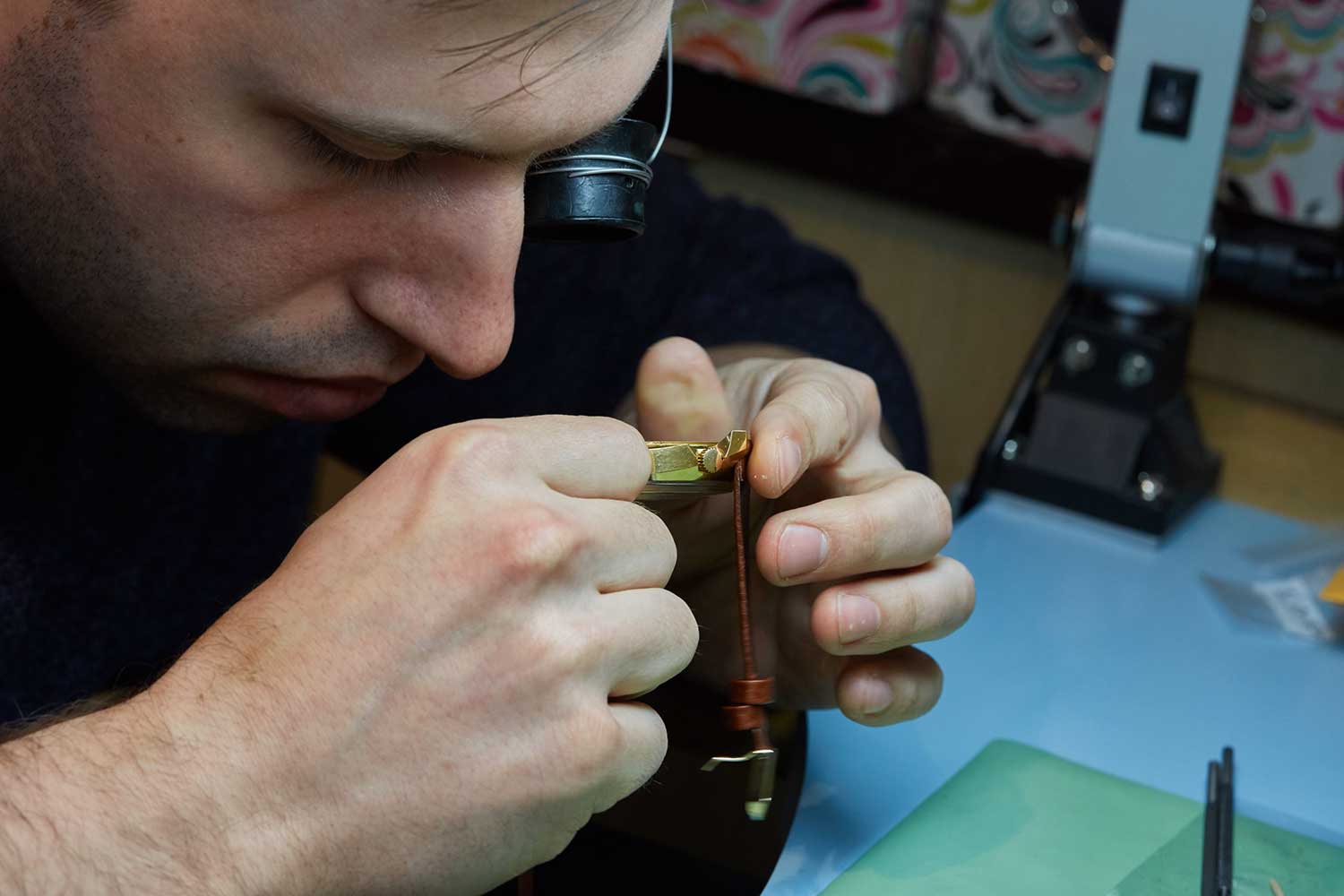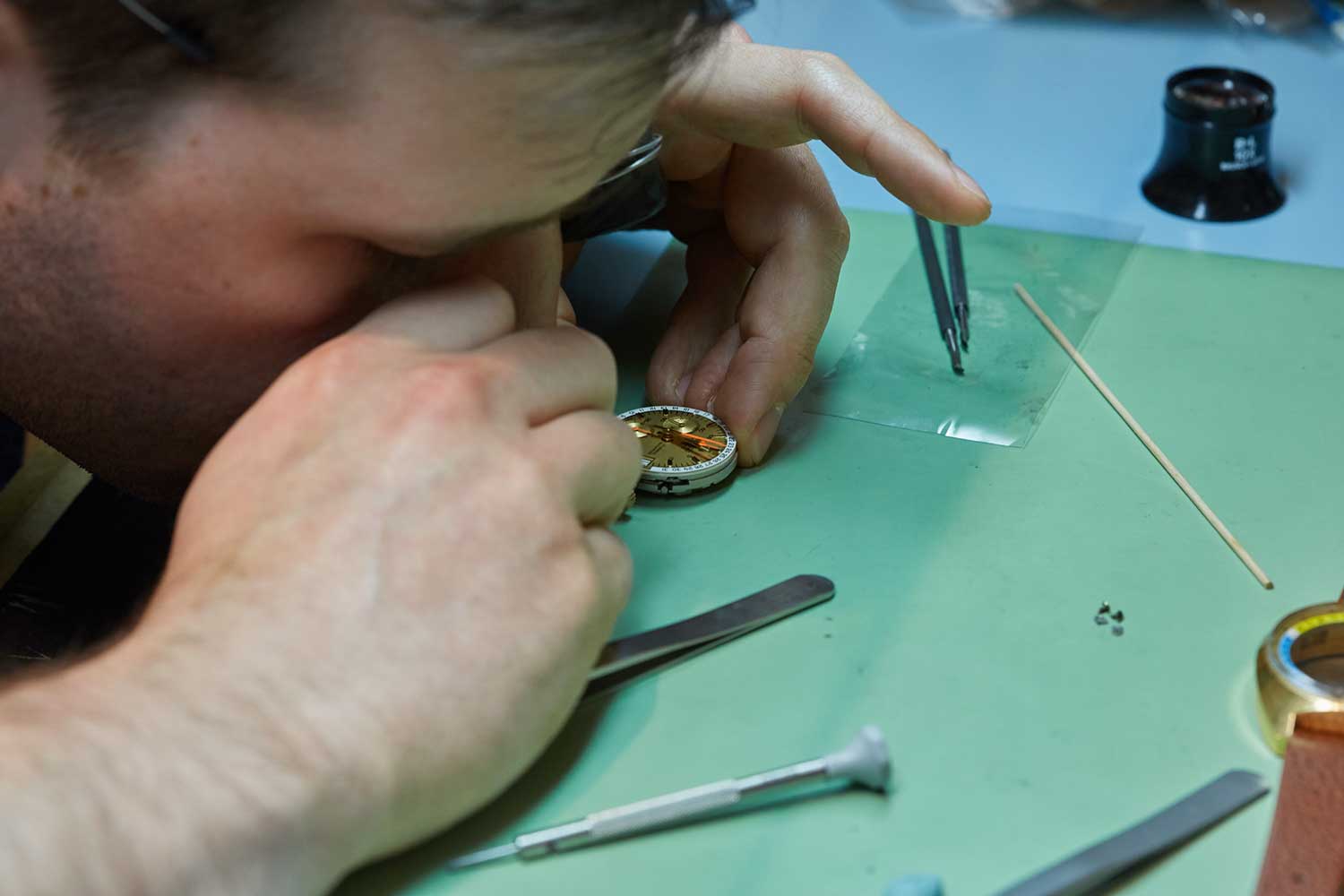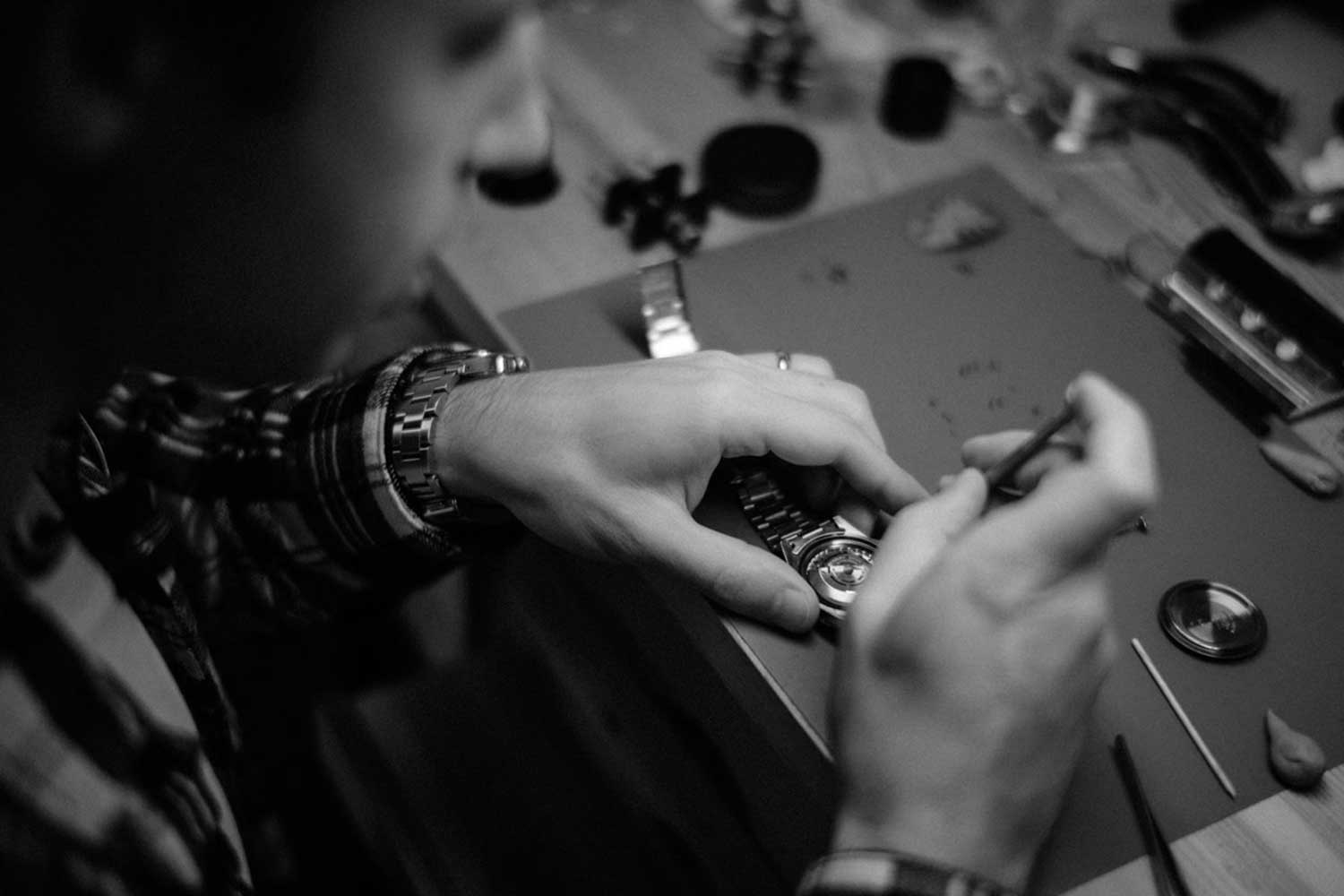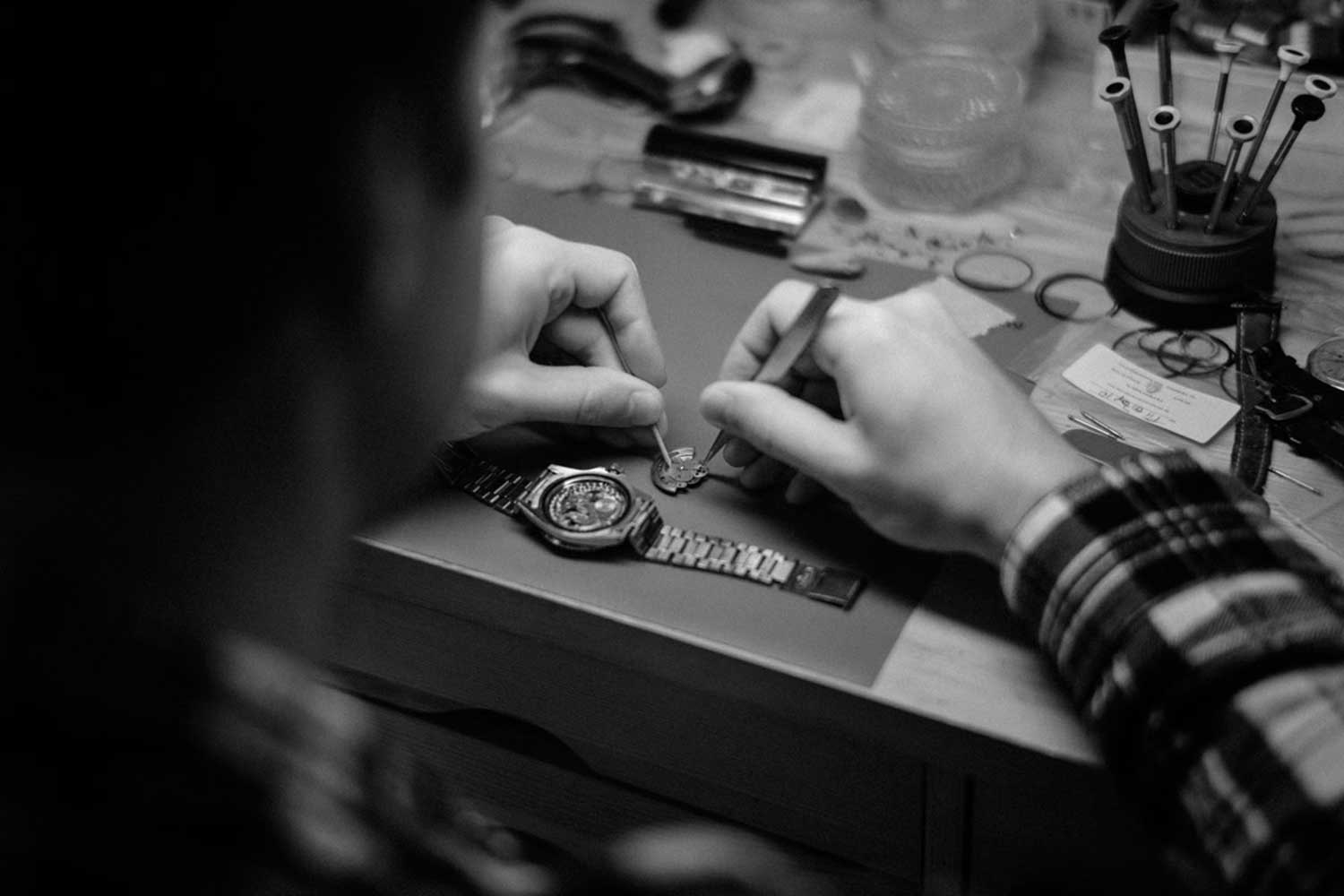We sat down with one of NYC’s most respected private watchmakers to shed some light on the mysteries of watch servicing.
You’ve finally done it. After months, perhaps years of planning, researching, saving, obsessing – you’ve bought yourself that watch. The watch. The watch you’ve been dreaming about. It’s magnificent. You bring it home, and begin your journey with your new timepiece companion. Days turn into weeks, weeks into months, months into years. Slowly but surely, the watch begins to take on the character of use. Maybe a scratch or two here, a small dent or abrasion there.
A little dirt begins to accumulate underneath the bezel, or within the links of the bracelet, and that high polish shine begins to dull ever so slightly. No matter—it was meant to be worn. Meant to be used. You’re proud of those scratches, that grime. But then one day, you begin to notice something is off… the time is a little wrong. Strange. Maybe you forgot to wind it? Sure, that must be it. You reset the watch and go about your day. But then a few days later, again, it’s a few hours slow. As the reality begins to sink in, you feel a cold chill go down your back – you need to have your watch serviced.
But what do you do now? Do you take your watch back to where you bought it? Surely it’s out of warranty now. Do you send it to the manufacturer? So many questions. But fear not! Recently, I sat down with my old friend Harris Freedman of
NYC Watchmaking to take the fear and guesswork out of getting your pride and joy serviced.
Revolution: Harris, welcome! Thank you for sitting down with me and helping to demystify for our readers the process of watch servicing. If you would, can you give us a little rundown on your background – who you are and how you got into watchmaking?
Freedman: Totally. My name’s Harris Freedman of NYC Watchmaking. I was doing sales and was really dissatisfied with that. But I was also into watches. I started selling watches, and realized I was dissatisfied with the act of selling, but not what I was selling. So I wanted a change, wanted to work with my hands, and dive a little deeper into watches. I found a mentor to take me under their wing and get my hands on some watches, learn how to fix them. And it all just took off from there and organically bloomed into what it is I’m doing now.
Revolution: Very interesting – so you apprenticed with another watchmaker, but did you go to watchmaking school and take classes or anything like that? Or did you just learn by doing?
Freedman: Just learned by doing. My mentor pretty much gave me cheap little watches that cost like, 150 bucks and said “see if you can get this running.” It didn’t run well, and it wasn’t clean, but by the end it was ticking. It was nice because you go to watchmaking school and you spend months on theory and you don’t touch a watch for the first six months to a year typically. Meanwhile I got hands-on right away with vintage watches, which really allowed me to build my hand skills. At the same time I had my own textbooks where I was studying after hours learning theory, what types of oils go where, cleaning, how to tell when it is clean, etc.
Revolution: That’s really cool. You had this combination of technical and academic foundation, but taught and applied in a hands-on, real world way rather than in a classroom setting over a prefixed period of time.
Freedman: I think it taught me, I want to say critical thinking in terms of figuring out why something’s not working or how things are put together. Which I think especially working on vintage watches is really helpful versus working on brand new watches.
Revolution: What is the biggest misconception that people have about having their watches serviced?
Freedman: So I think that the biggest misconception is that a watchmaker is a watchmaker and a mechanical watch, a mechanical watch. Fixing vintage watches is, I think, a different skill than repairing modern watches. Or to put it a different way, a lot of people who are trained on modern watches might not have the same problem solving skills that would be necessary to fix or figure out what’s going wrong with a vintage watch. They might really need the original workshop manual from the brand to put it together and without that they’re kind of lost. It’s really a different skill set.
Revolution: When should people bring their watches in for service? Alternatively, when should they not?
Freedman: There’s two camps, especially when it comes to Rolex, for example, that I’ve heard lots of people say. You don’t need to service your watch until it’s not keeping good time. And other people are: “Rolex says service it every five years, so you should do that or as close to it as possible.”
When I was selling watches, I was in the first camp of the, if it ain’t broke, don’t fix it – the brand is just trying to get more money out of you, etc. But the reality on the inside of the watch is very different. I guarantee those people have never opened up a watch, looked at pivots, the jewels, and seen the real wear and tear happening inside. And I guarantee if a watch that hasn’t been touched in decades but been worn every single day, even if it’s been keeping great time for three decades, is heavily worn.
Revolution: Interesting, so in forestalling service, even in a watch that maybe is keeping time ok, you might be inviting bigger problems down the road?
Freedman: Exactly. So I think I would say to avoid issues happening, bad timekeeping or watches breaking, get your watches serviced every three to five years, especially
vintage. For modern ones, I personally wouldn’t go longer than seven. It’ll just help keep longevity. There’ll be less wear on parts because they are lubricated the entire time that they’re running instead of lubricated for the first three to five years and then running fine for another two as they wear down and down and down. And then you have an issue.
Revolution: What are some dos and don’ts? Are there things people could figure out by googling or should they just call you at the first sign of trouble?
Freedman: Yeah, I would definitely say it never hurts to Google questions and try something easy, but I wouldn’t recommend opening your own watch up and taking the case back off or something like that. But I’ve had people come in and be like, my crown is broken, and it’s just a screw down crown which they can’t pull out because it’s screwed in. Knowing the difference between quartz and mechanical, etc. But in general, I have an open door policy – shoot me an email, ask me a “stupid” question, I’ll tell you you got to try winding a little bit more or I’ll hop on the phone with people, give them advice. Worst case I’ll say ship it over to me, I’ll take a look.
Revolution: Should people send their new watches back to the manufacturer or the AD for servicing once it’s out of warranty?
Freedman: I think there’s kind of two answers to that. One is depending on the question of how far out of warranty it is. If it’s decades, I would not recommend sending it to the AD. A lot of the people there haven’t seen stuff that’s decades old. So even if the brands will fix it, which some won’t for that old stuff, the people who are fixing it haven’t touched one of those in a long time – They’re only used to working on newer watches. Part two of that is that old stuff is getting collectible now and you don’t want to risk the chance of them polishing it (even if they say they won’t) or swapping out dials and stuff like that.
That having been said, if it’s a year, two year, three years out of warranty, unless you see it being highly collectible and you definitely don’t want polish or anything like that, I think the ad is generally fine.
Revolution: You mention case polishing, which is a hot button for a lot of people. Where do you stand, yay or nay?
Freedman: Personally? For my own watches, I’m a nay. I think visually to a collector, it’s a very personal choice. And I think there’s a lot of vintage guys who will look down on you if you do it. It comes down to what makes you happy – and if having a shiny case with no scratches makes them happy, obviously I think they should polish it.
When a client asks my advice, I will give them the knowledge and inform them that you can only polish it so many times and the more times you polish it, the more metal gets taken away. That could affect the value down the line. But I don’t think the primary purpose of collecting or the hobby should purely be about resale value. I like originality personally. I like how sharper cases look. So again, personally for me, no. And I would advise other people no as well, but I would never shame them or tell them they’re wrong if they do want it.
Revolution: If a watch was inexpensive to purchase, would it follow that that watch is going to be inexpensive to service?
Freedman: You would think. But that isn’t usually the case. Unfortunately, most of the cost is in tools and labor. So the labor to fix a cheap watch is the same as the labor to fix an expensive watch, they have the same components. You still have to take them apart, you have to clean everything, put it back together, get the timing set in. In fact, cheap ones can take even more time and effort than expensive ones because they’re not engineered as well, so they don’t go back together as easily.
Revolution: That’s very interesting. And kind of thinking about that in my mind, I always sort of thought of it as sort of like, hey, a three hand movement is a three hand movement. But that might not actually be the case. In fact the less expensive movement might actually be more difficult, more time consuming, more expensive to clean and service and reassemble than a more expensive movement.
Freedman: It really can be. And especially when they get more and more complicated, you have more complex parts in there that are cheaped out on – where there should be jewels, there aren’t jewels, for example. So if you go longer without servicing, it will wear much quicker. And then you have to rectify that and that takes more time and effort, or involves replacing larger components of the watch. So it’s kind of the opposite of what you would think. Cheaper watches can be in fact more expensive labor- and time-wise than some more expensive ones.
Revolution: If you have to replace internal parts – does that mean the watch has lost its originality or is a… FRANKENWATCH? [THUNDER CLAPS AND LIGHTNING]
Freedman: It’s a good question. I hear that term getting thrown around all sorts. I don’t know that people really know what it means. For me, it comes down to a couple of things – there’s the discussion of preservation versus restoration as opposed to building out a watch to intentionally fake something. To me, a Frankenwatch would be like if you’re putting in an incorrect bridge from another watch and it’s got a different serial number on it or it’s got a different finish to it just to build a watch together so you have something functional and working. It’s putting in a part that wasn’t originally in there or never should have been in there in that form, but is functional and that to me then makes it an imposter.
Revolution: Interesting. So say you have a watch with a base ETA2824 in it, and a tooth breaks off of a wheel, so you go and take a wheel from another 2824, but maybe it’s a generic one, not the derivative that the brand used. It has the same barrel, but it’s not from that manufacturer’s gussied up version. Is that a bridge too far for you (no pun intended)?
Freedman: To me it depends on the finish because, especially you said an ETA 2824, a lot of brands use those movements and ETA has a couple different grades of the base movement that they sell and then sometimes the brands will alter the movements themselves or adjust
the finishing or something like that. So for me, is it the same finish? Is it the same version of the part? Is it truly indistinguishable? The trick is knowing which parts are which.
Revolution: How can people vet their potential watchmaker or service center to feel more confident in their capabilities? What are some red flags to look out for?
Freedman: I think word of mouth is really valuable here. Talk to some other collectors who’ve had things serviced, see what kind of experience they’ve had and see if they were happy with it or not. I think other than that, it would be to reach out and talk to the watchmaker in question.
I have an open door policy – you can email me, I’ll email back personally or I’ll hop on the phone with a lot of people before they’ve even sent me work. We have the discussion, what do they want done with their watch? What are they looking to get out of this experience? So if you can do that, I think that’s really where you get a step up with smaller independent shops versus much larger ones or going back to the factory. You end up with a more individual, more personalized experience.
Talking about the red flags, I’m going to go back to quoted price range. You get what you pay for, if it sounds too good to be true, most likely it is. There’s a reason why they’re undercutting on price and there’s things that won’t be done or will be skipped out on to get it to make sense at that whatever hourly rate it is or per job rate or anything like that.
Revolution: If everybody else is quoting you $1,200 to service something and then you find a guy who’s willing to do it for $350… maybe you should at least have an eyebrow raised at that, right?
Freedman: You’re probably going to get the 47th street dip on that one – put it in a tub of solvent, let it sit for 20 minutes, pull it out, spread oil with the paintbrush all over it.
Revolution: And then everyone wonders how vintage watches get over oiled or have big old oil slicks and moisture damage all over them.
Freedman: Exactly. So yeah, I’d say word of mouth recommendations and try and talk to them directly. If you can talk to them, you get along with them, if they’re passionate about watches, they’re happy to do work with you, to get it exactly how you want it and to be honest and real with you. I think that’s a great place to start.
Revolution: If there was one key takeaway point for our readers, regarding the process or experience of having their watches serviced, what would that be?
Freedman: Let’s see, how do I want to say this? Go in with the knowledge and the confidence that it’s about you as the customer. I think a lot of times you go into a watchmaking shop and the company or the watchmaker will try and make it all about them or about the watch – what they have time for, when they can get to it, what they want to do to it, and it doesn’t really need to be like that.
There are definitely things that need to be done that you might not know about, but I think if they’re not giving you the conversation, if they’re not explaining to you what they’re going to do to your watch and you’re not walking away understanding the process, I think that’s an issue. I think there’s a big problem in the industry about transparency and communication and customer service, and as a result people don’t go in expecting those things and I think they should.
Revolution: Interesting. So they should come away from that conversation, from the evaluation, having a general understanding of what is going to be done to their watch and, most importantly, why it’s going to be done, and what it’s going to cost.
Freedman: Exactly. If they say something like, we’re going to replace the crystal, and they don’t tell you why they want to replace the crystal. You should feel comfortable and be able to ask what the reason is for replacing it. If they say we have to replace the hands or we won’t do the service without replacing the hands. The customer should be made aware and at least then be given the choice of saying, okay, I don’t want to do it.
Revolution: It seems a lot like taking your car to a mechanic.
Freedman: In my head pretty much exactly the same thing. And I fix my own cars as a hobby on the weekends. It’s just a different tool set. The tools tend to be quite a bit larger and it’s just working on a larger thing, and with watches, you have gaskets to keep moisture out of the watch and with cars you have gaskets and o-rings to keep it all inside the engine, but other than that, it’s essentially the same thing.





















